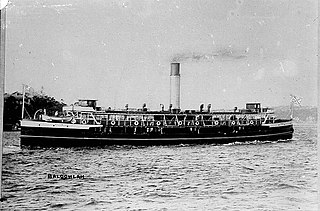The United States Navy, United States Coast Guard, and United States National Oceanic and Atmospheric Administration (NOAA) use a hull classification symbol to identify their ships by type and by individual ship within a type. The system is analogous to the pennant number system that the Royal Navy and other European and Commonwealth navies use.

SS Robin is a 350 gross registered ton (GRT) steam coaster, a class of steamship designed for carrying bulk and general cargoes in coastal waters, and the oldest complete example in the world. One of a pair of coasters built in Bow Creek, London in 1890, the ship was built for British owners, but spent most of her long working life on the Spanish coast as Maria.

Sydney Heritage Fleet, is the trading name of Sydney Maritime Museum Ltd., a public company in Sydney, New South Wales, Australia.

SS Nomadic is a former tender of the White Star Line, launched on 25 April 1911 at Belfast, that is now on display in Belfast's Titanic Quarter. She was built to transfer passengers and mail to and from the ocean liners RMS Olympic and RMS Titanic. She is the only surviving vessel designed by Thomas Andrews, who also helped design those two ocean liners, and the last White Star Line vessel in existence today.

The Dee Why and Curl Curl, were two identical steam ferries servicing Sydney Harbour's Circular Quay to Manly service. Both commissioned in 1928, they were the largest ferries on Sydney Harbour until the 1938 introduction of the South Steyne.

SS Balgowlah was a ferry on Sydney Harbour operated by the Port Jackson & Manly Steamship Company on the Manly service from 1912 until 1951.

RMS Quetta was an iron-hulled steamship that was built in Scotland in 1881 and wrecked with great loss of life in the Torres Strait in 1890. She was operated by British India Associated Steamers (BIAS), which was controlled by the British India Steam Navigation Company (BISN). She was wrecked on a previously unknown rock, which has been called Quetta Rock ever since. The Underwater Cultural Heritage Act 2018 protects the wreck.

The Greycliffe disaster occurred in Sydney Harbour (Australia) on 3 November 1927 when the harbour ferry Greycliffe and the Union Steamship Company mail steamer Tahiti collided. The smaller ferry was cut in two and sank with the loss of 40 lives, the deadliest incident on Sydney Harbour.

SS Orsova, was a British ocean liner, built by Vickers Armstrong in Barrow-in-Furness, England, for the Orient Steam Navigation Company for their Great Britain-to-Australia services via the Suez Canal. She was the final development of the 28,000 ton class which began with the SS Orcades of 1948 and continued with the SS Oronsay of 1951. In 1960, in conjunction with the introduction of the new larger and faster Oriana and Canberra, the fleets of Orient and P&O were combined as P&O-Orient Lines, although the Orient ships retained their corn-coloured hulls and sailed under their own house flag. In 1966, P&O acquired the balance of the Orient shares and the Orient Line was discontinued, with Orsova and her fleet mates being transferred to the ownership of the Peninsular & Oriental Steam Navigation Company (P&O), painted white and under the P&O houseflag.

The SS South Steyne is a former Manly ferry on Sydney Harbour. She was the world's largest steam-powered passenger ferry and operated on the service from 1938 to 1974. Restored in the 1980s, she served as a restaurant ship in Newcastle in the 1990s, and in 2000 was moved back to Sydney and open to the public at Darling Harbour. Since April 2016 she has been stored at Berrys Bay. She was added to the New South Wales State Heritage Register on 2 April 1999.

Burra Bra was a Manly ferry on Sydney Harbour that operated by the Port Jackson & Manly Steamship Company from 1908 until 1940, before being requisitioned by the Royal Australian Navy for use as an anti-submarine training vessel and target tow during World War II.

MV Baragoola was a ferry formerly operated by the Port Jackson & Manly Steamship Company and its successors on the Manly service.

The MV North Head was a ferry operated by the Port Jackson & Manly Steamship Company and its successors on the Manly service from 1913 until 1985.

Bellubera was a ferry operated by the Port Jackson & Manly Steamship Company on the Manly service. Launched in 1910, she was the third of six "Binngarra-type" vessels. Upon her 1936 conversion from steam power, she became the first diesel-electric vessel in Australia. She was decommissioned in 1973, and scuttled at sea in 1980.

Kirawa was a ferry on Sydney Harbour. She was a near identical sister vessel with Kanangra both of which were launched in 1912 during the early-twentieth pre-Sydney Harbour Bridge boom years of Sydney Ferries Limited.

Binngarra was a ferry operated by Port Jackson & Manly Steamship Company on the Manly service. Launched in 1905, she was the first of six similar vessels built for the company–the Binngarra class—the success of which saw three of her sister vessels serving through to the 1970s and 1980s.

Wallaby was a ferry that operated on Sydney Harbour.

Kanangra is a retired ferry on Sydney Harbour. She was launched in 1912 during the early-twentieth century pre-Sydney Harbour Bridge boom years of Sydney Ferries Limited.

SS River Burnett was a cargo steamship that was built in Queensland in 1946 and scrapped in Taiwan in 1973. She was a member of the "A"-class of standard cargo ships built for the Australian Shipbuilding Board between 1943 and 1947.
































